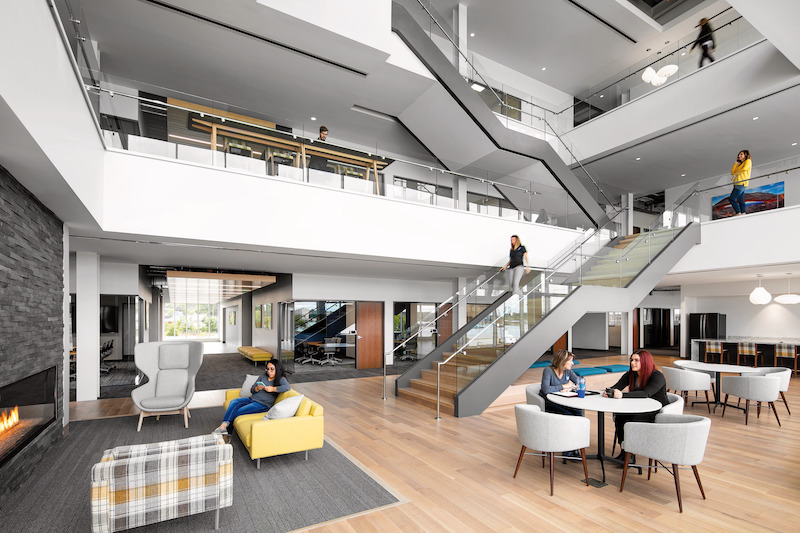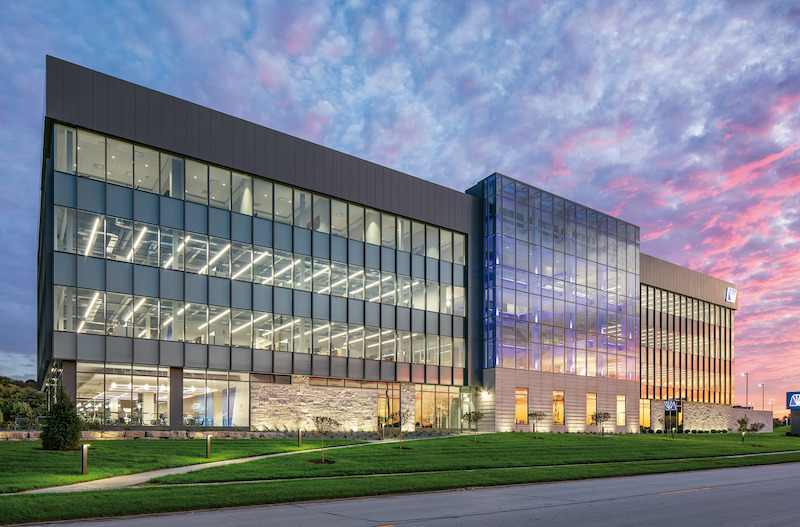Located next to the Mississippi River in Moline, Ill., the new IH Mississippi Valley Credit Union (IHMVCU) headquarters has completed construction. The LEO A DALY-designed building was designed to reflect an employee-centered culture.
The 92,000-sf facility consolidates about 300 employees from other locations and serves as the center of operations among the company’s 13 locations in Western Illinois and Eastern Iowa. A three-story atrium faces the Mississippi River and uses its sweeping views of the river valley to encourage occupants to take the stairs. The atrium is illuminated by a digital multiplex system that expresses the IHMVCU brand through LED lighting. The lighting can also be changed to reflect special occasions such as turning red, white, and blue on the Fourth of July.

The building’s nearly translucent north facade and punched windows on the other three building faces (which together use more than 600 panes of glass) make interior daylighting possible. Headquarters amenities include a fitness area, cafe, indoor and outdoor community spaces, lounges, fireplaces, and supplies for post-workday events or entertaining clients.
See Also: New social campus for innovators, tech leaders covers a full city block
LEO A DALY led all design services for the project, including architecture, interior design, and electrical, mechanical, and structural engineering.
Related Stories
| Jun 2, 2014
Parking structures group launches LEED-type program for parking garages
The Green Parking Council, an affiliate of the International Parking Institute, has launched the Green Garage Certification program, the parking industry equivalent of LEED certification.
| May 29, 2014
7 cost-effective ways to make U.S. infrastructure more resilient
Moving critical elements to higher ground and designing for longer lifespans are just some of the ways cities and governments can make infrastructure more resilient to natural disasters and climate change, writes Richard Cavallaro, President of Skanska USA Civil.
| May 28, 2014
KPF's dual towers in Turkey will incorporate motifs, symbols of Ottoman Empire
The two-building headquarters for Turkey’s largest and oldest financial institution, Ziraat Bank, is inspired by the country’s cultural heritage.
| May 27, 2014
One World Trade Center cuts rents due to sluggish activity
Sluggish economy and lackluster leasing force developer The Durst Organization and the Port Authority of New York and New Jersey to reduce asking rents by nearly 10% to $69/sf.
| May 23, 2014
Big design, small package: AIA Chicago names 2014 Small Project Awards winners
Winning projects include an events center for Mies van der Rohe's landmark Farnsworth House and a new boathouse along the Chicago river.
| May 23, 2014
Top interior design trends: Gensler, HOK, FXFOWLE, Mancini Duffy weigh in
Tech-friendly furniture, “live walls,” sit-stand desks, and circadian lighting are among the emerging trends identified by leading interior designers.
| May 22, 2014
Big Data meets data centers – What the coming DCIM boom means to owners and Building Teams
The demand for sophisticated facility monitoring solutions has spurred a new market segment—data center infrastructure management (DCIM)—that is likely to impact the way data center projects are planned, designed, built, and operated.
| May 22, 2014
No time for a trip to Dubai? Team BlackSheep's drone flyover gives a bird's eye view [video]
Team BlackSheep—devotees of filmmaking with drones—has posted a fun video that takes viewers high over the city for spectacular vistas of a modern architectural showcase.
| May 21, 2014
Check out Pandora's posh NYC offices [slideshow]
The new East Coast office for the Internet radio provider is housed on two interconnected floors of the classic 125 Park Avenue building, and features multiple spaces for music performances, large gatherings, and “all hands” meetings.
| May 20, 2014
Kinetic Architecture: New book explores innovations in active façades
The book, co-authored by Arup's Russell Fortmeyer, illustrates the various ways architects, consultants, and engineers approach energy and comfort by manipulating air, water, and light through the layers of passive and active building envelope systems.
















